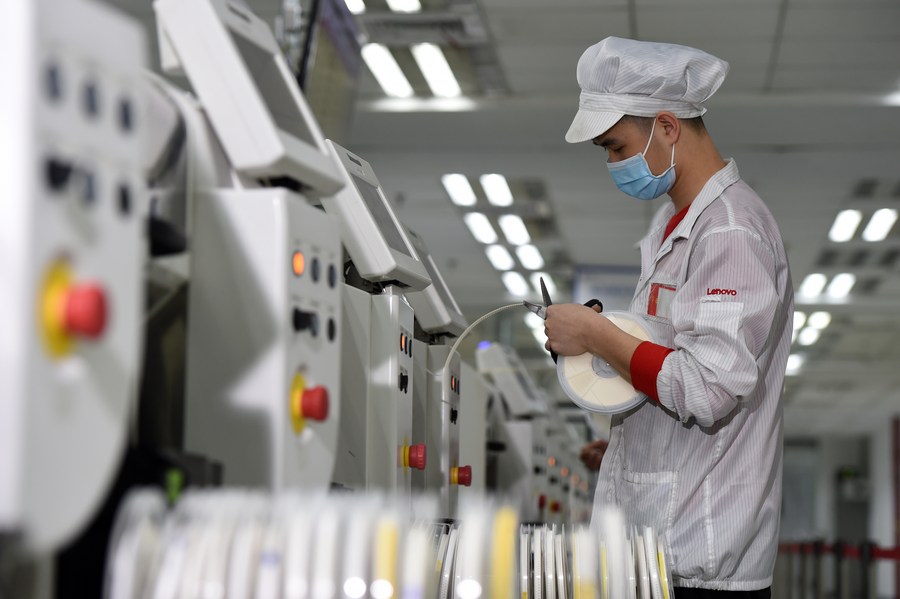Staying resilient, China varies industrial-chain means in 2022

Photo taken on March 5, 2020 shows a worker at the manufacturing shop of LCFC (Hefei) Electronics Technology Co., Ltd. in Hefei, capital of east China's Anhui Province. [Xinhua/Zhou Mu]
BEIJING -- China, the world's largest manufacturer, has seen many of its industries tested by the jitters of COVID-19 outbreaks and geopolitical turbulences in 2022. However, industrial and supply chains in various sectors showed proven resilience in withstanding disturbances.
In the first 11 months, the total added value of industrial enterprises above the designated size registered a 3.8-percent year-on-year growth, with that of high-tech manufacturing climbing 8 percent compared to a year ago.
What underpins China's steady industrial economic growth is the smooth and functioning industrial and supply chains, which even emerged stronger from downward pressure thanks to a raft of innovative attempts to keep the ball rolling.
DATA-DRIVEN DECISION-MAKING
As COVID-19 flare-ups complicated the market situation by disrupting production and logistics, many local governments and firms resorted to unhindered digital paths to find the way out.
In late February, a COVID-19 outbreak hit south China's high-tech hub Shenzhen, posing challenges to the regular production of a local factory with laptop giant Lenovo. With a data-based smart supply chain management system known as SCI, the company analyzed the factory's orders and the production capacity of another factory in east China's Hefei City to arrange an order transfer.
Within a day, the system helped the factory run through the bill of material, contracts, and quotations. Within three days, the Shenzhen factory's orders of 75,000 laptops were transferred to Hefei. Within a week, all the materials and components were ready, helping deliver the orders smoothly and efficiently.
Amid the epidemic, east China's tech-savvy Zhejiang Province has even developed a digital application to manage the industrial chains.
The application, featuring various functions, helps enterprises master the real-time supply and demand changes in the industry's upstream and downstream links and adjust to the potential risks of chain breaks. The platform also enables government agencies to coordinate efforts and make timely decisions.
"You have to make more use of data and let it be processed faster," said Lu Shan, deputy governor of Zhejiang. "It will help reengineer the overall process and reshape the system of industrial and supply chains."
REGIONAL CLUSTER
To forge a more resilient firewall against risks to industrial and supply chains, many places across China introduced a chain-chief mechanism to leverage industrial synergy for win-win growth.
In the multi-player scheme, the local government, with a senior official as chain chief, encourages and supports an industrial giant to act as a chain leader to expand the ecosystem and coordinate efforts for shared development.
In Guangzhou City's Panyu District in south China's manufacturing giant Guangdong Province, over 40 automobile parts and related enterprises gather in a new energy vehicle (NEV) industrial park. GAC AION, the chain leader in the park, could assemble a NEV in about a minute thanks to the efficient supply from partner firms.
The company sold over 240,000 units of cars in the first 11 months of this year, more than double the total of 2021.
Guangdong has introduced a project to nurture chain leaders in 20 strategic industries, including automobiles and smart home appliances. Some 60 enterprises playing the role of chain leaders are expected to be in place in 2025.
"The chain-chief scheme is not only about building a solid industrial chain. It also seeks to drive innovation, maintain stable supply and climb up the value chain," said Long Jianhui, a researcher with the Guangdong Academy of Social Sciences.
GLOBAL LAYOUT
Promoting local industrial clusters doesn't mean backtracking in cross-region cooperation. Instead, the COVID-19 epidemic has underscored the importance of global cooperation in a world with emerging uncertainties.
Many enterprises with overseas businesses have expanded their global layout regarding supplies and logistics to avoid putting all eggs in one basket.
In addition to domestic factories, home appliance maker Midea has developed a vast overseas manufacturing network, with about half of its major production bases located overseas.
Many traders are also setting up warehouses overseas. Known as the hub of small commodities, Yiwu has established over 160 overseas warehouses.
"Previously, it took seven to 15 days for a single parcel to reach the terminal, but from overseas warehouses, it can reach customers in as little as two days," said Xu Ruoying, general manager of Yiwu-based Duoman Trading Company.
In September, China, together with other five countries, proposed an initiative of international cooperation on resilient and stable industrial and supply chains, aiming at a community with a shared future for global development to address common risks and challenges.
"International cooperation is not an option. It has become a must," said Xin Guobin, vice minister of industry and information technology. "Global industrial and supply chains hold broad prospects for win-win international cooperation."
























